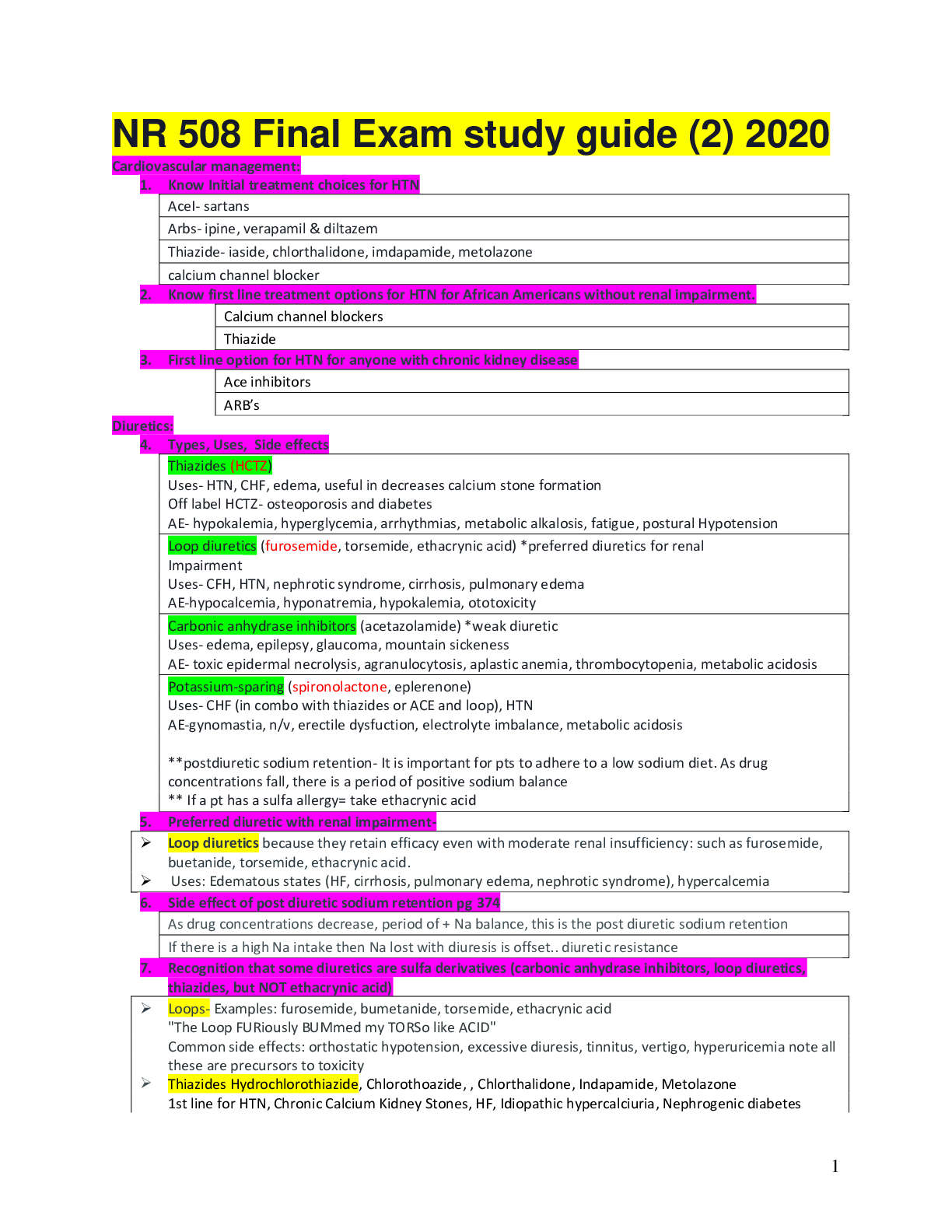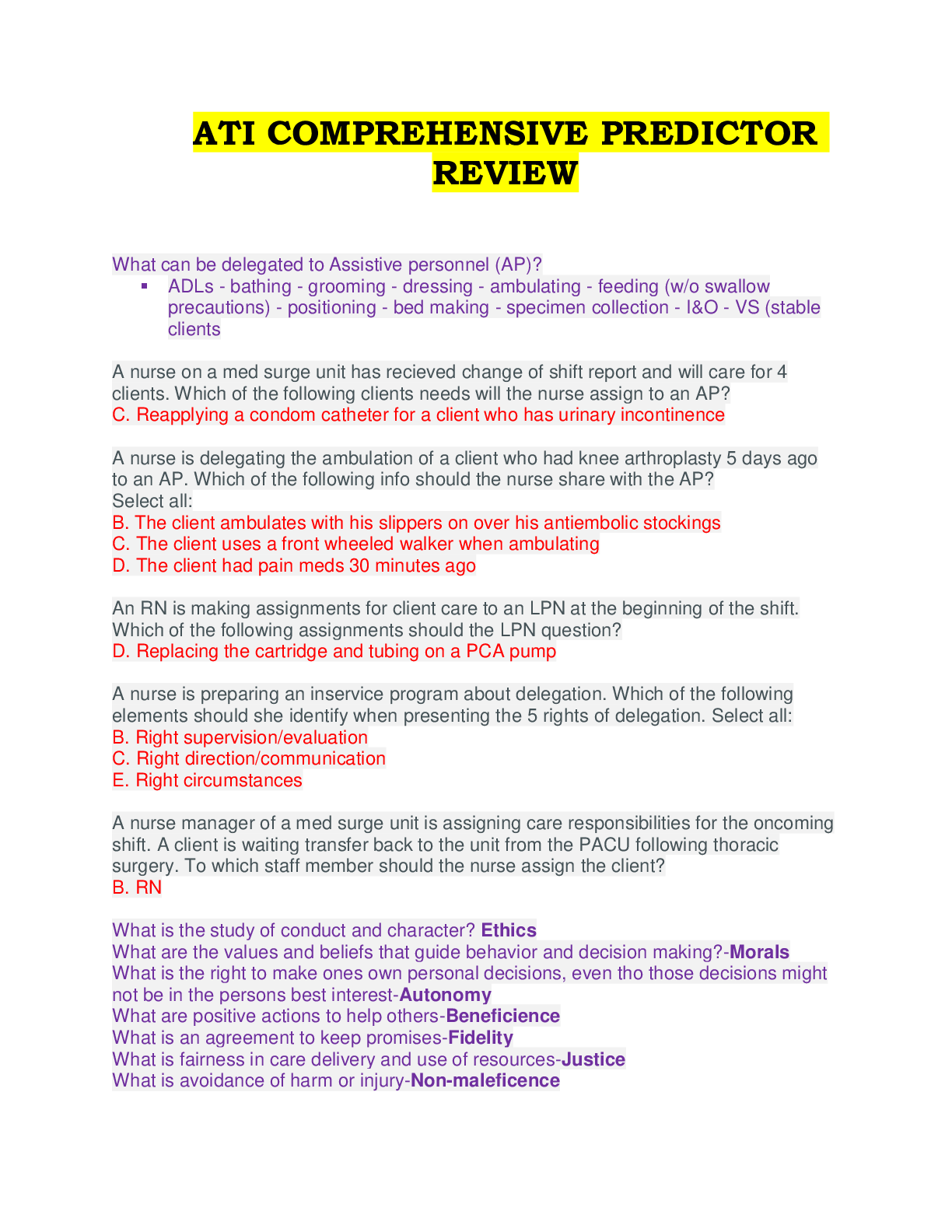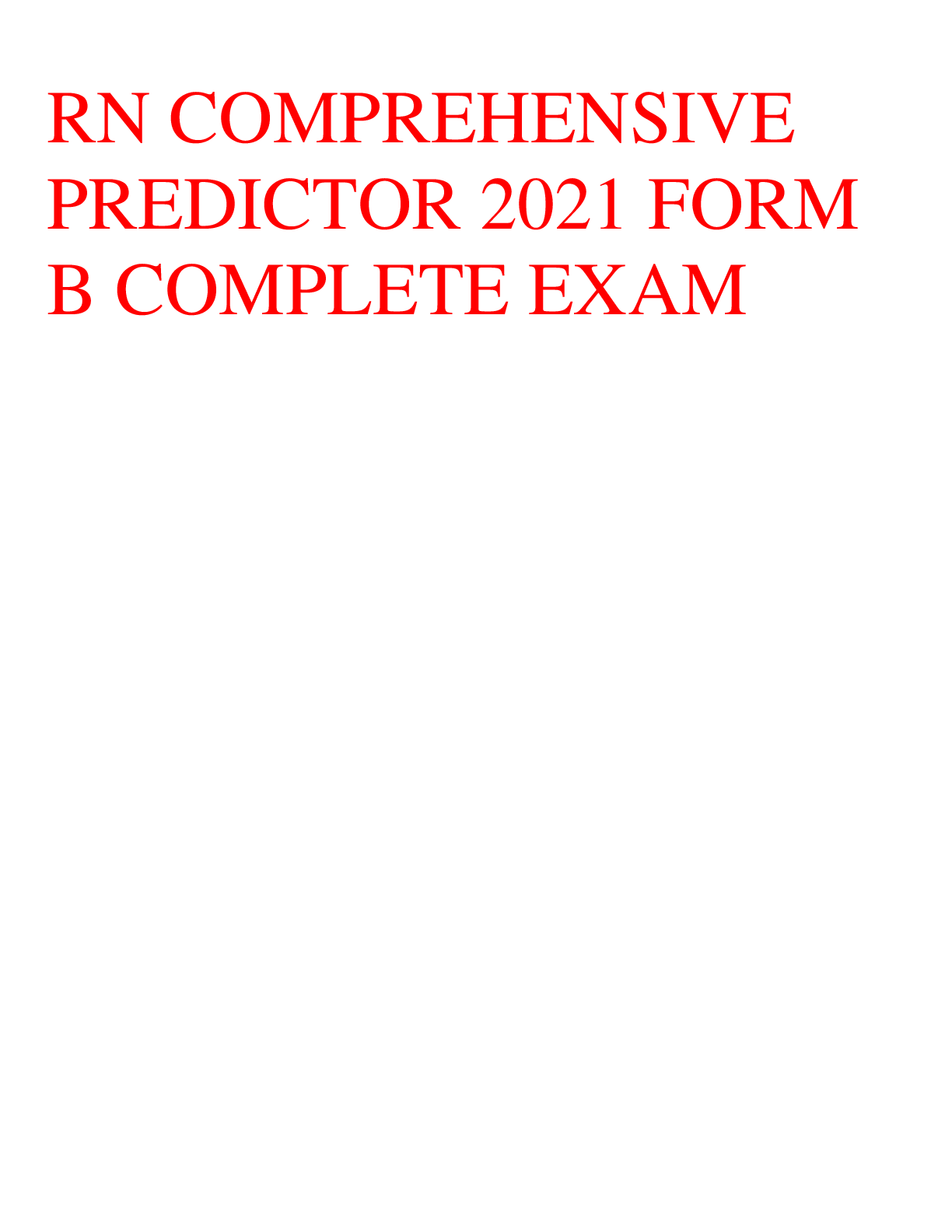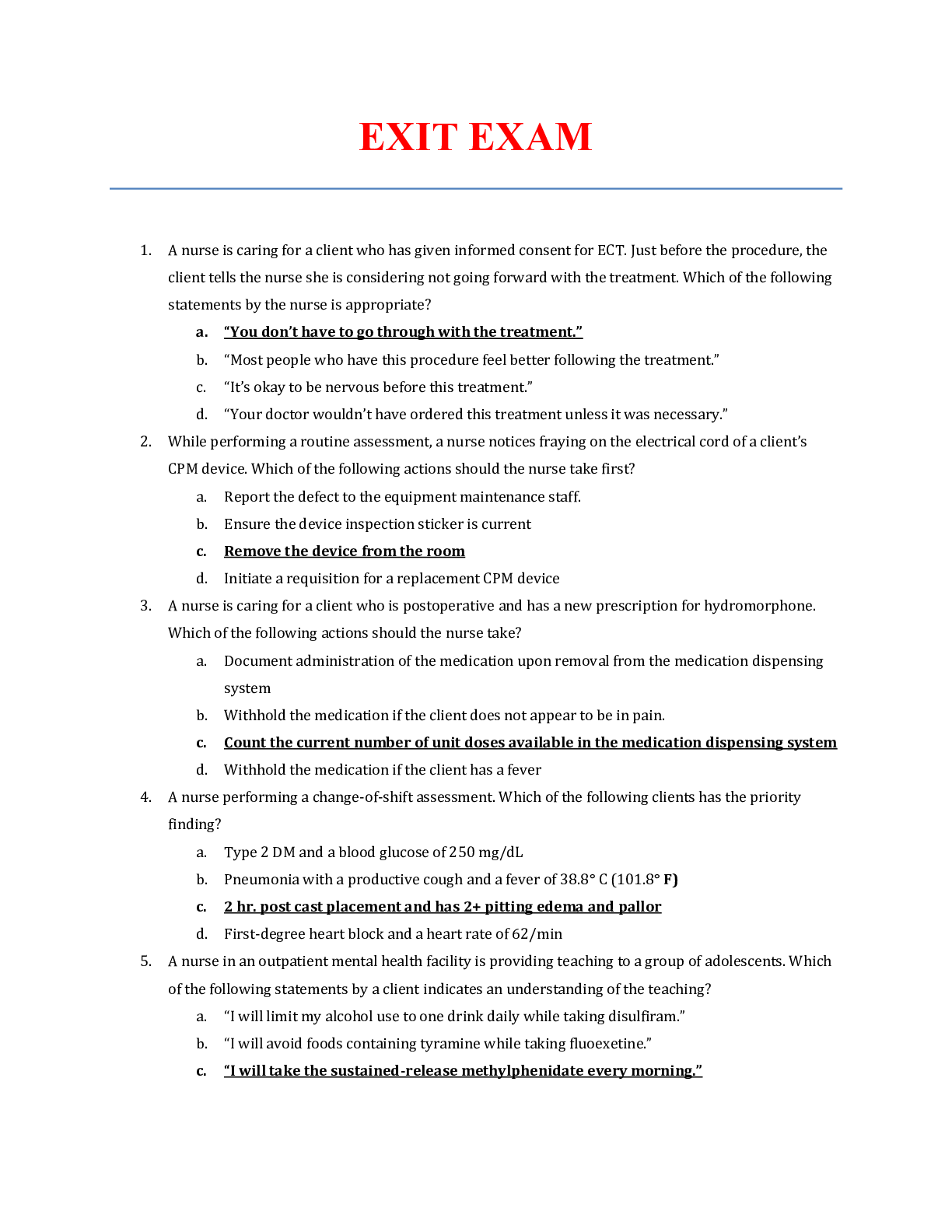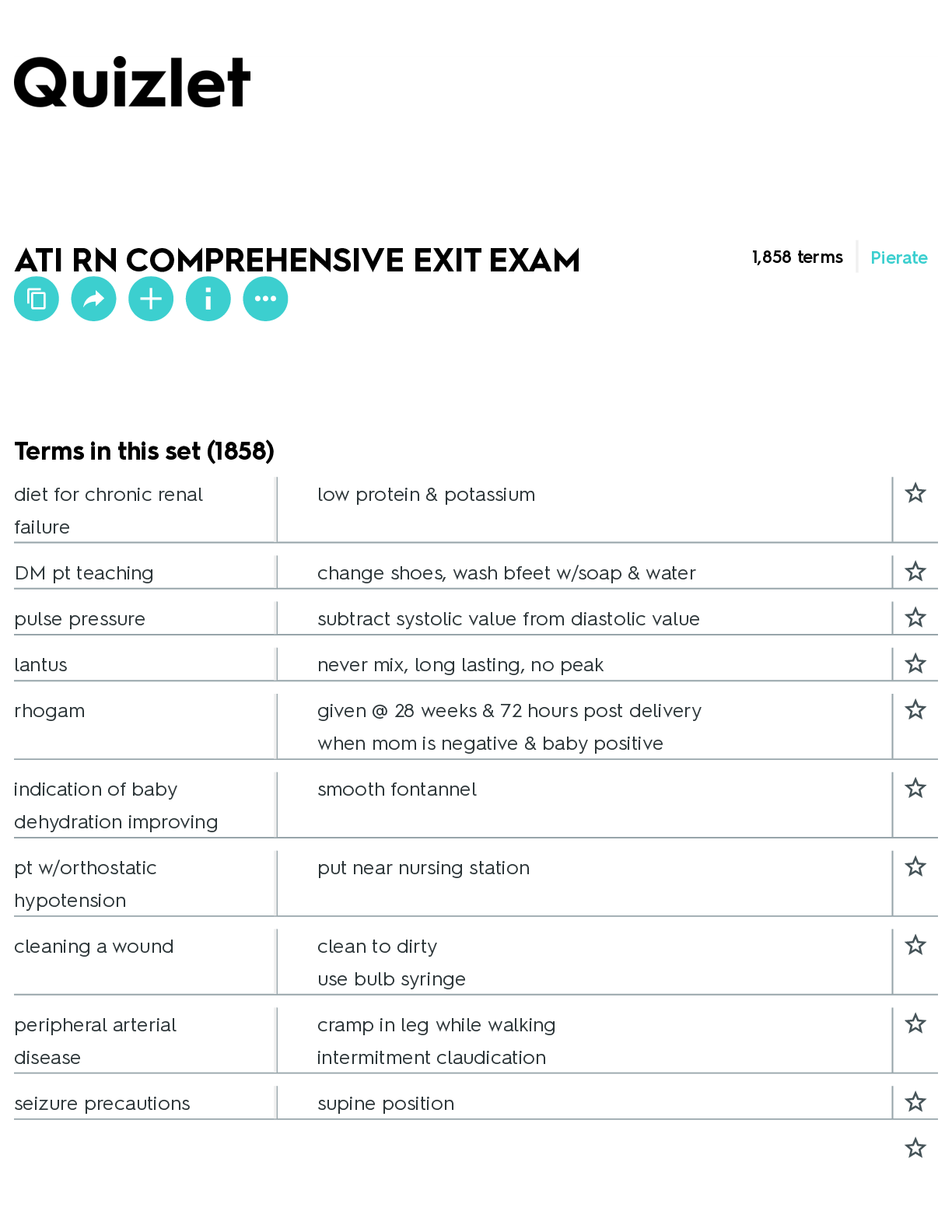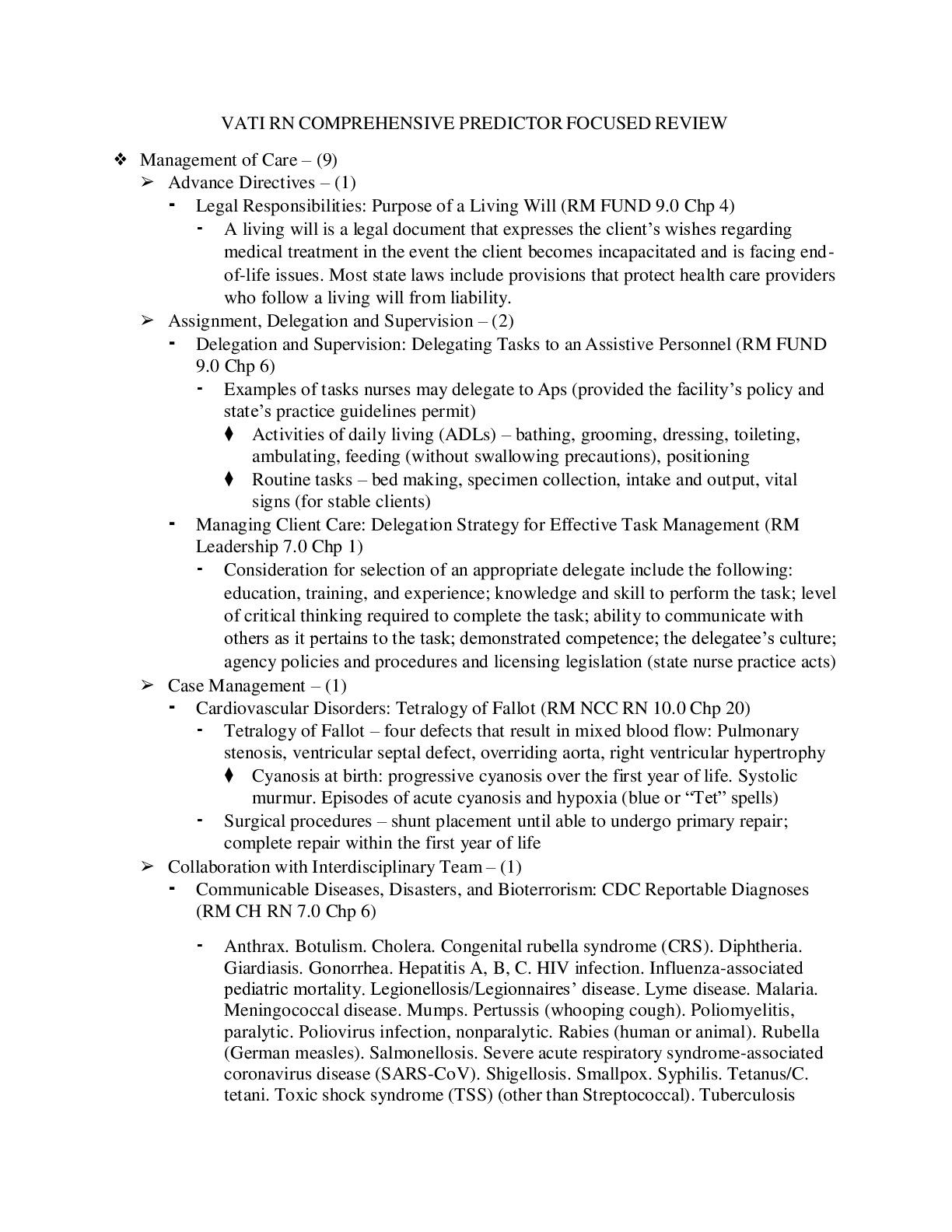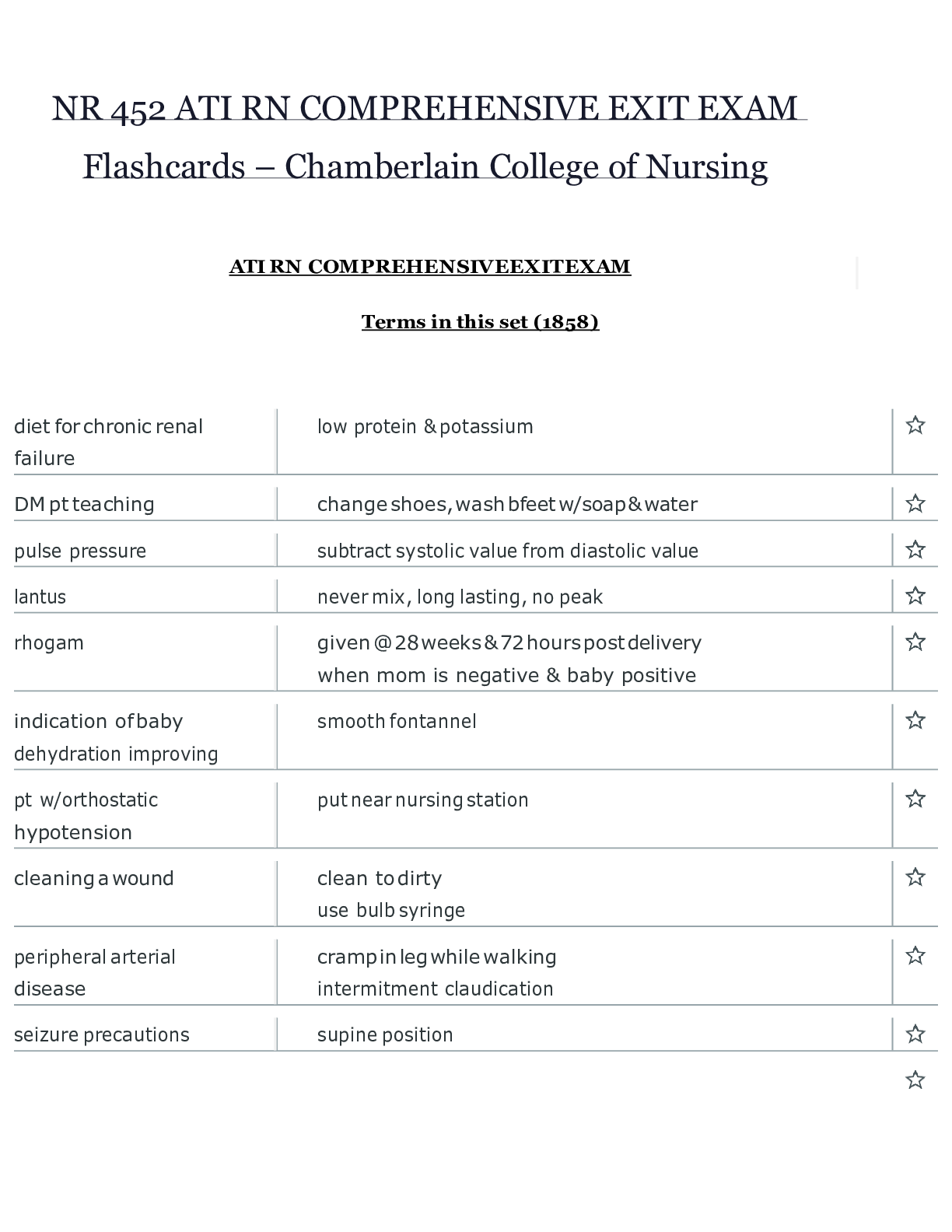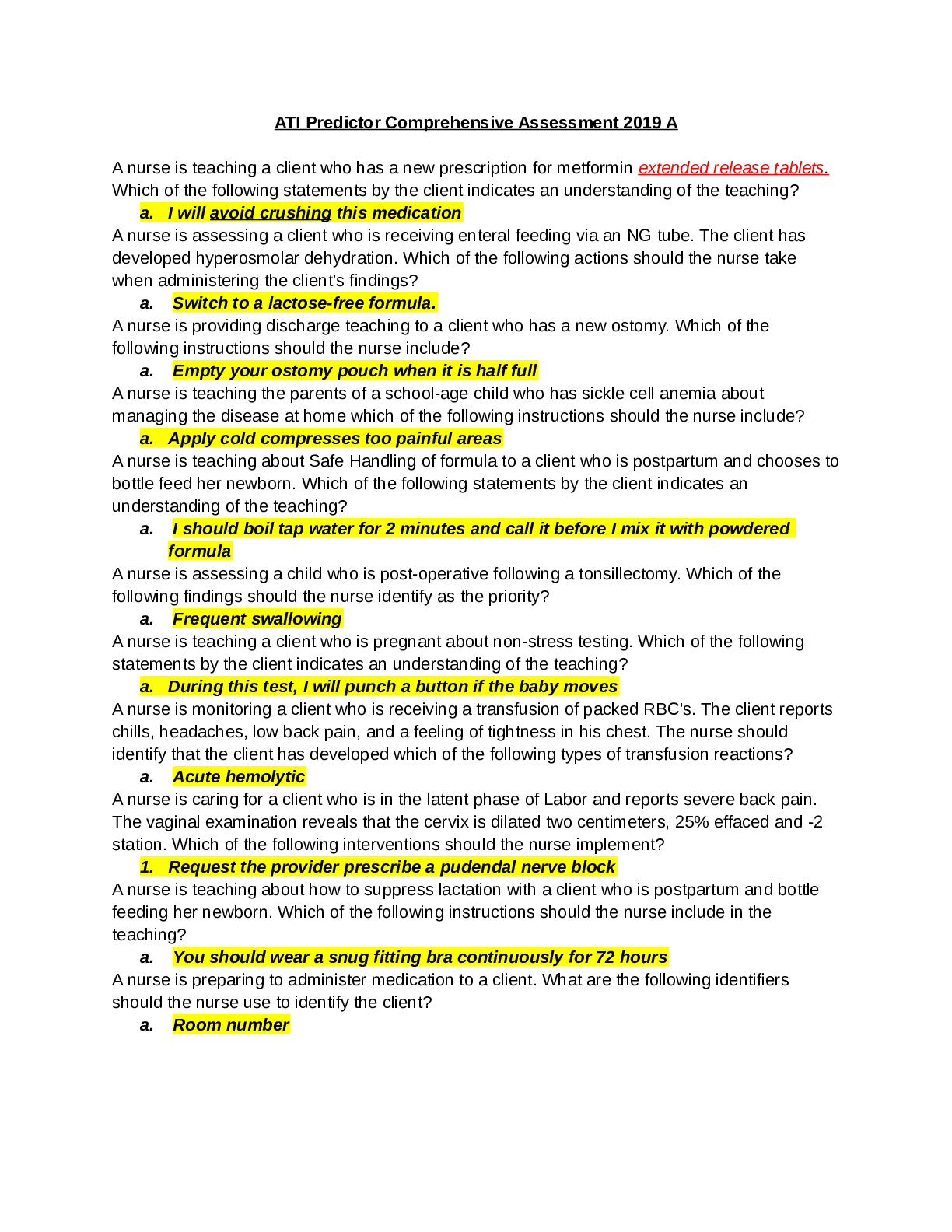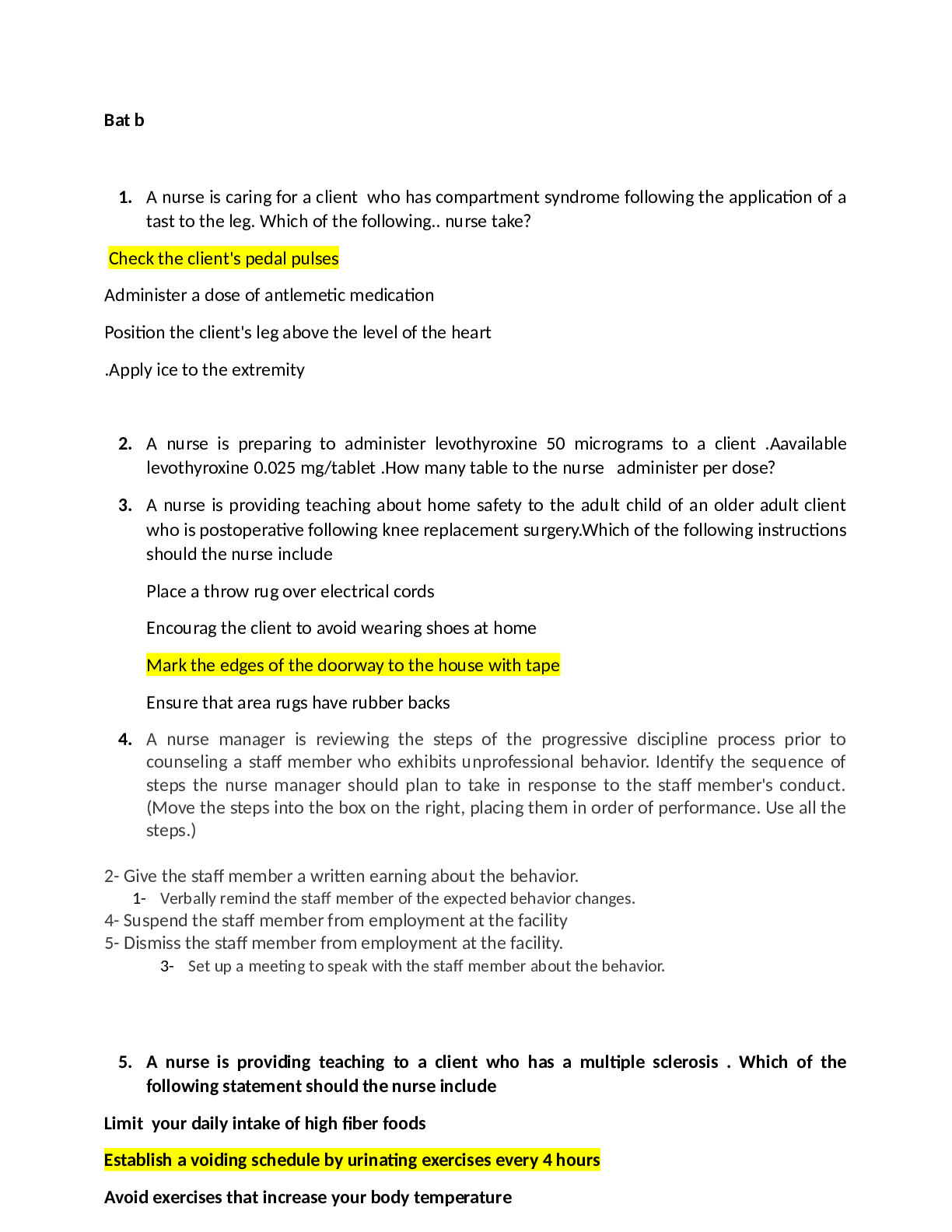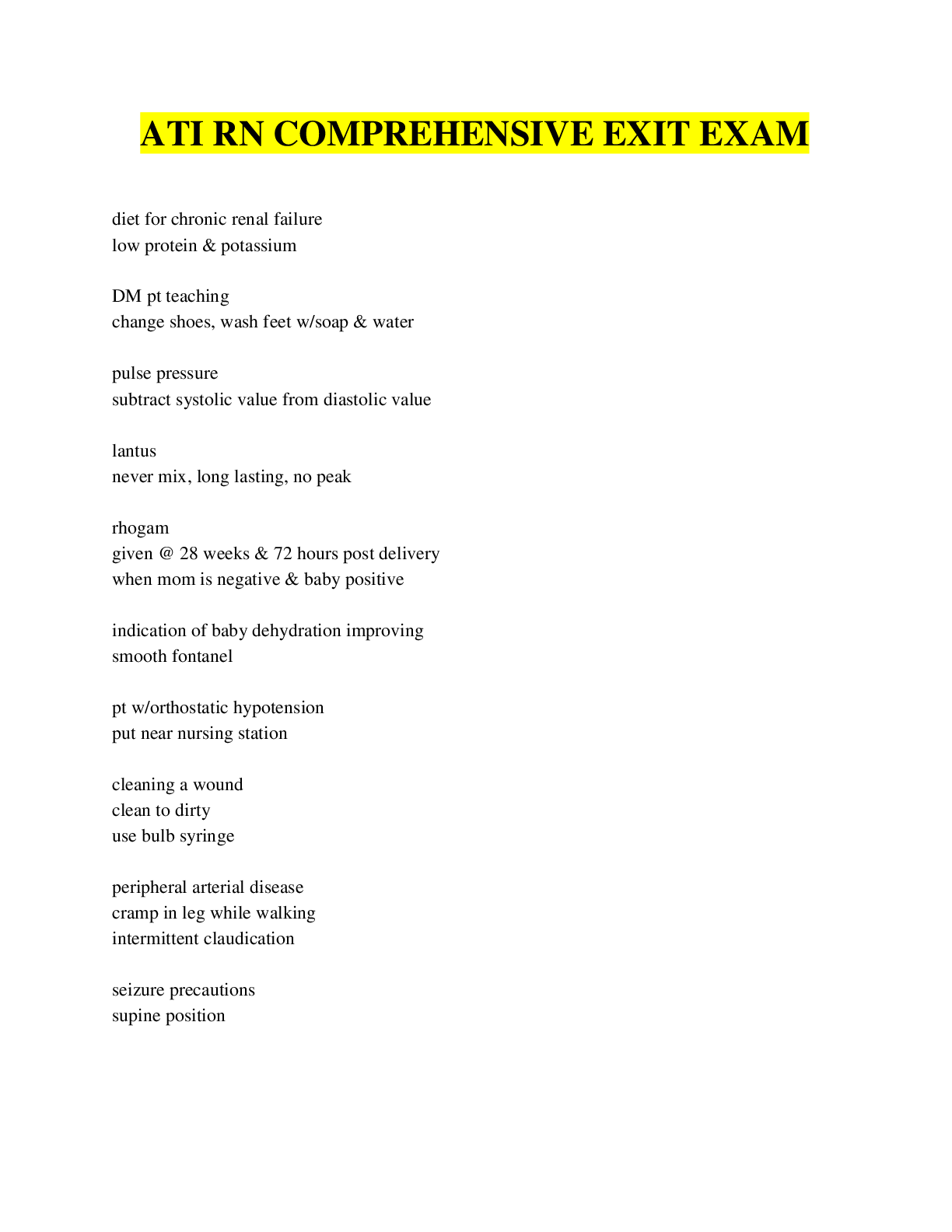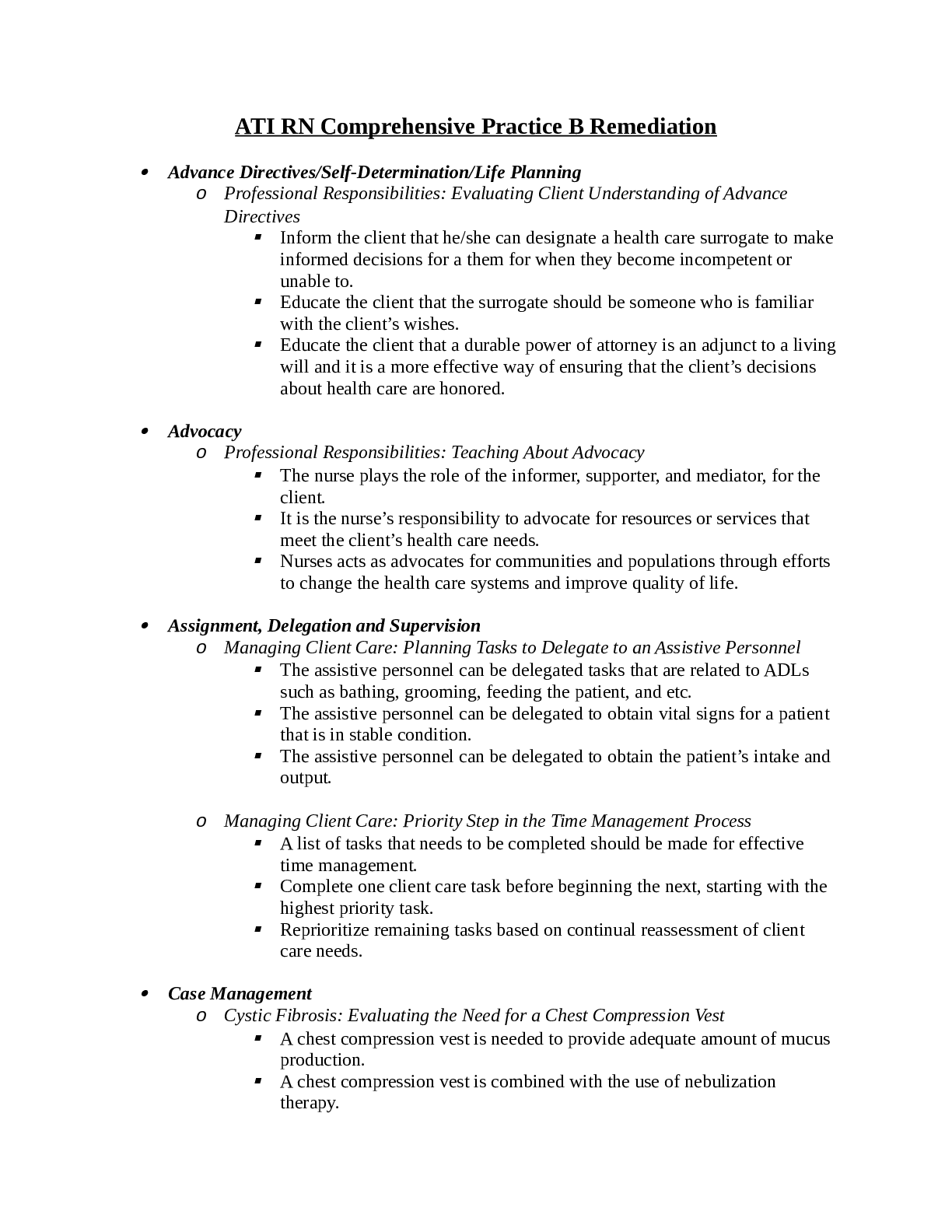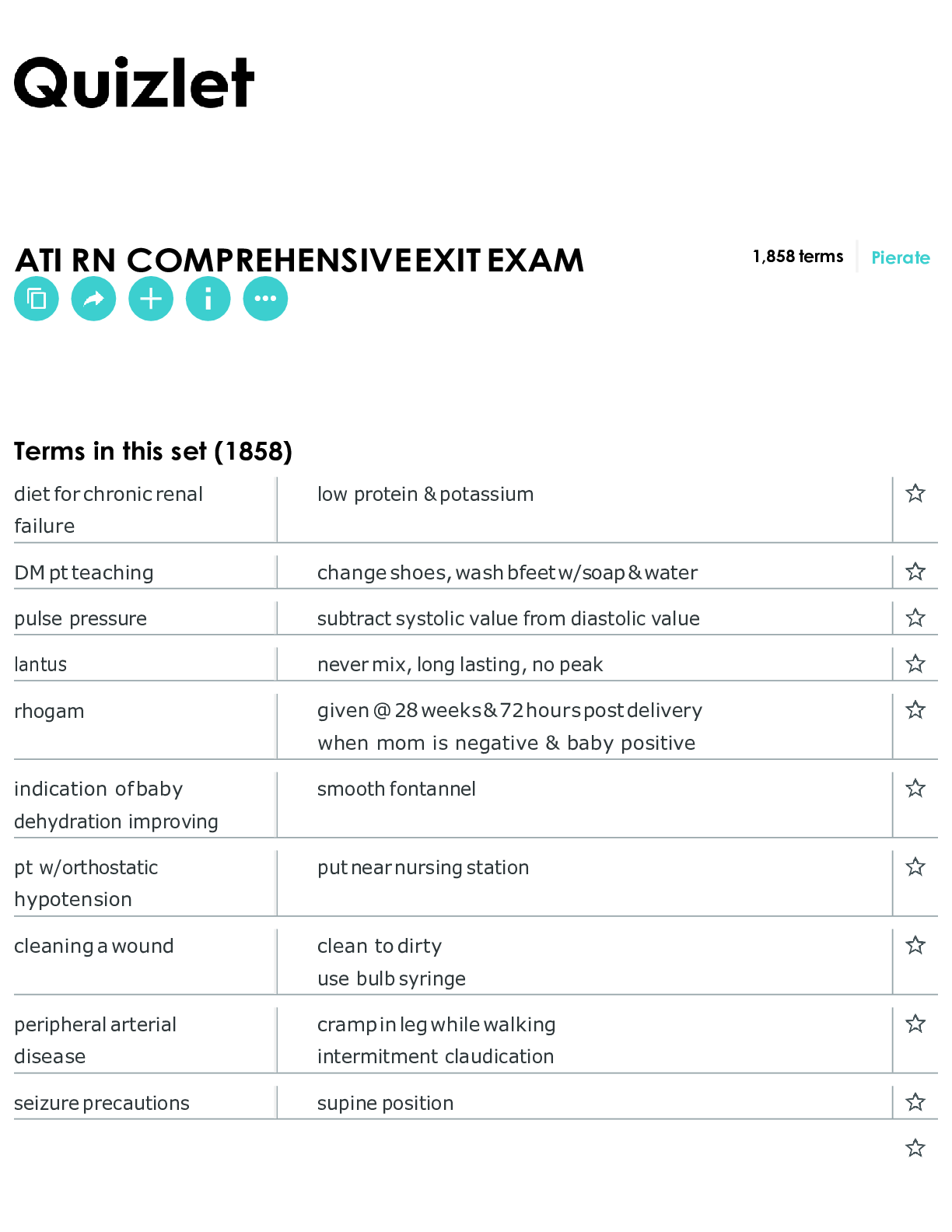*NURSING > QUESTIONS and ANSWERS > HLTH 216 ATI RN COMPREHENSIVE PREDICTOR 2019/2020 REMEDIATION (All)
HLTH 216 ATI RN COMPREHENSIVE PREDICTOR 2019/2020 REMEDIATION
Document Content and Description Below
HLTH 216 ATI RN COMPREHENSIVE PREDICTOR 2019/2020 REMEDIATION Management of Care – (9) Advance Directives/Self-Determination/Life Planning – (1) Professional Responsibilities: Cli... ent Teaching About Do-Not-Resuscitate Orders (Active Learning Template – Basic Concept, RM Leadership 7.0 Chp. 3) Unless a do not resuscitate (DNR) or allow natural death (AND) prescription is written, the nurse should initiate CPR when a client has no pulse or respirations. The written prescription for a DNR or AND must be placed in the client’s medical record. The provider consults the client and the family prior to administering a DNR or AND. Client Rights – (1) Coordinating Client Care: Appropriate Action When a Client Leaves Against Medical Advice (Active Learning Template – Basic Concept, RM Leadership 7.0 Chp. 2) A client who leaves a facility without a prescription for discharge from the provider is considered leaving against medical advice (AMA). A client who is legally competent has the legal right to leave the facility at any time. The nurse should immediately notify the provider. If the client is at risk for harm, it is imperative that the nurse explain the risk involved in leaving the facility. The individual should sign a form relinquishing responsibility for any complications that arise from discontinuing prescribed care. The nurse should document all communication, as well as the specific advice that was provided for the client. A nurse who tries to prevent the client from leaving the facility can face legal charges of assault, battery, and false imprisonment. Collaboration with Interdisciplinary Team – (1) Coordinating Client Care: Information to Report to Occupational Therapist (Active Learning Template – Basic Concept, RM Leadership 7.0 Chp. 2) Patient’s condition and current status; any medications the patient is on; patient’s tolerance level for pain; any assistive devices the patient uses Confidentiality/Information Security – (1) Professional Responsibilities: Protecting Confidential Client Information (Active Learning Template – Basic Concept, RM Leadership 7.0 Chp. 3) It is essential for nurses to be aware of the rights of clients in regard to privacy and confidentiality. Facility policies and procedures are established in order to ensure compliance with HIPAA regulations. It is essential that nurses know and adhere to the policies and procedures. HIPAA regulations also provide for penalties in the event of noncompliance with the regulations. Continuity of Care – (1) Information Technology: Preparing a Change-of-Shift Report (Active Learning Template – Basic Concept, RM FUND 9.0 Ch 5) Nurses give this report at the conclusion of each shift to the nurse assuming responsibility for the clients. Formats include face to face, audiotaping, or presentation during walking rounds in each client’s room (unless the client has a roommate or visitors are present). An effective report should: include significant objective information about the client’s health problems; proceed in a logical sequence; include no gossip or personal opinion; relate recent changes in medications, treatments, procedures, and the discharge plan Legal Rights and Responsibilities – (1) Professional Responsibilities: Understanding Regulations for Nursing Scope of Practice (Active Learning Template – Basic Concept, RM Leadership 7.0 Chp. 3) Standards of care guide, define, and direct the level of care that should be given by practicing nurses. They also are used in malpractice lawsuits to determine if that level was maintained. Nurses should refuse to practice beyond the legal scope of practice and/or outside of their areas of competence regardless of reason (staffing shortage, lack of appropriate personnel). Nurses should use the formal chain of command to verbalize concerns related to assignment in light of current legal scope of practice, job description, and area of competence. Performance Improvement (Quality Improvement) – (1) Maintaining a Safe Environment: Demonstrating Quality and Safety Education for Nurses Competencies (Active Learning Template – Basic Concept, RM Leadership 7.0 Chp. 4) Safe use of equipment refers to appropriate operation of health care-related equipment by trained staff. Equipment-related injuries can occur as a result of malfunction, disrepair, or mishandling of mechanical equipment. Nurses must ensure that they have the competence necessary to use equipment for tasks that fall within their scope of practice. Nurses should use equipment only after receiving sufficient instruction. Equipment should be regularly inspected by the engineering or maintenance department and by the user prior to use. Faulty equipment (frayed cords, disrepair) can start a fire or cause an electrical shock and should be removed from use and reported immediately per agency policy. Referrals – (2) Alzheimer’s Disease: Resources for Home Care (Active Learning Template – System Disorder, RM AMS RN 10.0 Chp 8) Refer to social services and case managers for long-term/home management, Alzheimer’s Association, community outreach programs, and support groups Nutrition and Oral Hydration: Priority Finding Following an Ischemic Stroke (Active Learning Template – System Disorder, RM FUND 9.0 Ch 39) Identify if someone has dysphagia, this patient will need pureed foods; clear and full liquids plus pureed meats, fruits and scrambled eggs, low residue: low in fiber Safety and Infection Control – (6) Accident/Error/Injury Prevention – (2) Adverse Effects, Interactions, and Contraindications: Priority Action to an Allergic Response (Active Learning Template – Medication, RM Pharm RN 7.0 Chp 5) Treat with epinephrine, bronchodilators, and antihistamines. Provide respiratory support and inform the provider. Health Promotion of Infants (2 Days to 1 Year): Car Seat Safety (Active Learning Template – Basic Concept, RM NCC RN 10.0 Chp 3) Infants and toddlers remain in a rear-facing car seat until the age of 2 years or the height recommended by the manufacturer. The safest area for infants and children is the backseat of the car. Do not place rear-facing car seats in the front seat of vehicles with passenger airbags. Infants should not be left in parked cars. Emergency Response Plan – (1) Facility Protocols: Nursing Role During Mass Casualty Incident (Active Learning Template – Basic Concept, RM Leadership 7.0 Chp. 5) Principles of mass casualty triage should be followed in health care institutions involved in a mass casualty event. These differ from the principles of triage typically following during provision of day-to-day services in an emergency or urgent care setting. During mass casualty events, casualties are separated related to their potential for survival, and treatment is allocated accordingly. This type of triage is based on doing the greatest good for the greatest number of people. Nurses can find this situation very stressful because clients who are not expected to survive are cared for last. Home Safety – (1) Nursing Care and Discharge Teaching: Teaching About Newborn Safety (Active Learning Template – Basic Concept, RM MN RN 10.0 Chp 26) Never leave the newborn unattended with pets or other small children. Keep small objects (coins) out of the reach of newborns due to choking hazard. Never leave the newborn alone on a bed, couch, or table. Newborns move enough to reach the edge and fall off. Never place the newborn on his stomach to sleep during the first few months of life. The back-lying position is the position of choice. The newborn can be placed on his abdomen when awake and being supervised. Standard Precautions/Transmission-Based Precautions/Surgical Asepsis – (1) Medical and Surgical Asepsis: Setting Up a Sterile Field (Active Learning Template – Nursing Skill, RM FUND 9.0 Ch 10) Open the covering of the package per the manufacturer’s directions, slipping the package onto the center of the workspace with the top flap of the wrapper opening away from the body. Grasp the tip of the top flap of the package, and with arm positioned away from the sterile field, unfold the top flap away from the body. Next, open the side flaps, using the right hand for the right flap and the left hand for the left flap Grasp the last flap and turn it down toward the body. Use of Restraints/Safety Devices – (1) Complications of Infants: Treatment of Positional Plagiocephaly (Active Learning Template – Therapeutic Procedure, RM NCC RN 10.0 Chp 42) Educate parents about the importance of daily “tummy time” when infant is awake. Educate parents of the importance of alternating the infant’s head position during sleep. Refer parents to physical therapy for neck exercises. Assist parents in the proper use of the skull-molding helmet. Educate parents that the helmet needs to be worn 23 hr/day, usually for 3 months. Educate parents to continue to place infant in the supine position for sleep. Health Promotion and Maintenance – (8) Aging Process – (1) Chronic Neurologic Disorders: Teaching About Phenytoin (Active Learning Template – Medication, RM Pharm RN 7.0 Chp 13) Monitor for manifestations of CNS effects, and notify the provider if they occur Advise clients to maintain good oral hygiene (dental flossing, massaging gums). Folic acid supplements can decrease the occurrence. Stop medication if rash develops. Administer at slow IV rate (no faster than 50 mg/min) and in dilute solution to prevent adverse cardiovascular effects. Avoid administering to a client who has sinus bradycardia, sinoatrial block, or Stokes-Adams syndrome Instruct client to report changes. Encourage the client to consume adequate amounts of calcium and vitamin D. Administer prophylactic vitamin K to the mother for 1 month before the infant is delivered. Ante/Intra/Postpartum and Newborn Care – (2) Complications Related to the Labor Process: Findings to Report to the Provider (Active Learning Template – Basic Concept, RM MN RN 10.0 Chp 16) Prolapsed umbilical cord and Meconium-stained amniotic fluid Nursing Care and Discharge Teaching: Circumcision (Active Learning Template – Therapeutic Procedure, RM MN RN 10.0 Chp 26) Circumcision is the surgical removal of the foreskin of the penis. It is a personal choice made by the newborn’s family for reasons of health and hygiene, religious conviction (Jewish male on eighth day after birth), tradition, culture, or social norms. Parents should make a well-informed decision in consultation with the provider. Circumcision should not be done immediately following birth because the newborn’s level of vitamin K is at a low point, and the newborn would be at risk for hemorrhage. Health Promotion/Disease Prevention – (2) Pediatric Emergencies: Planning Education About Sudden Infant Death Syndrome (Active Learning Template – Basic Concept, RM NCC RN 10.0 Chp 43) Teach the family how to reduce the risk of SIDS: place the infant on the back for sleep; avoid exposure to tobacco smoke; prevent overheating; use a firm, tightfitting mattress in the infant’s crib; remove pillows, quilts, and stuffed animals from the crib during sleep; ensure that the infant’s head is kept uncovered duringsleep; offer pacifier at naps and night; encourage breastfeeding; avoid cosleeping; maintain immunizations up to date. Practice Settings and Aggregates: Recommended Health Screenings for Young Adult Male Clients (Active Learning Template – Basic Concept, RM CH RN 7.0 Chp 4) Height/weight; blood pressure; dental health; digital rectal exam; fecal occult blood test/sigmoidoscopy (50 years and older); immunization status: check the CDC, www.cdc.gov, for current administration schedules; diabetes mellitus; HIV; skin cancer; cholesterol (ages 45 to 65 years) Health Screening – (2) Health Promotion of Infants (2 Days to 1 Year): Finding to Report (Active Learning Template – Basic Concept, RM NCC RN 10.0 Chp 3) If the baby does not cry because this is the first form of verbal communication, or if the amount of crying does not decrease by 12 weeks of age. Also, if any of the stages of development are either not met or are delayed at any moment. If there is any suspicion that there is injury to the baby or delayed development. Osteoporosis: Dietary Recommendations for Health Promotion (Active Learning Template – Basic Concept, RM AMS RN 10.0 Chp 70) Instruct the client and family regarding dietary calcium food sources; Instruct the client to limit excess caffeine, alcohol, and carbonated beverages, which increase bone loss; Provide information regarding calcium and vitamin D supplementation. (Take with food); Instruct the client on the need for adequate amounts of protein, magnesium, vitamin K, and other trace minerals needed for bone formation Techniques of Physical Assessment – (1) Electrolyte Imbalances: Priority Assessment for Suspected Hypocalcemia (Active Learning Template – System Disorder, RM AMS RN 10.0 Chp 44) Laboratory tests – calcium level less than 9.0 mg/dL Diagnostic procedures – electrocardiogram changes: Prolonged QT and ST interval Tetany is the most common manifestation seen in clients in a hypocalcemic state. It is caused by neural excitability-spontaneous discharges from both the sensory and motor fibers (peripheral nerves). Psychosocial Integrity – (4) Behavioral Interventions – (1) Personality Disorders: Caring for a Client Who Has Antisocial Personality Disorder (Active Learning Template – System Disorder, RM MH RN 10.0 Chp 15) Promote therapeutic communication to lower anxiety, decrease defensive patterns, and encourage participation in the milleu. Establish a trusting relationship with the client and encourage the development of social skills and friendships, as well as, encourage participation in group work and psychoeducation Cultural Awareness/Cultural Influences on Health – (1) Cultural, Ethnic, and Religious Influences: Food Selections for a Client Who Follows a Kosher Diet (Active Learning Template – Basic Concept, RM Nutrition 6.0 Chp. 6) Kosher meat – bulls, cows, sheep, lambs, goats, veal, and springbok Some birds – goose, duck, chicken, and turkey Dairy products that contain only kosher animals Eggs of kosher birds only Only fish with fins and scales All products that grow in the soil or on plants, bushes, or trees are kosher Support Systems – (1) Neurocognitive Disorders: Teaching Family Members of a Client Who Has Dementia (Active Learning Template – System Disorder, RM MH RN 10.0 Chp 17) Educate family/caregivers about the client’s illness, methods of care, and adaptation of the home environment Ensure a safe environment in the home Home safety measures – remove scatter rugs; install door locks that cannot be easily opened; lock water heater thermostat and turn water temperature down to a safe level; provide good lighting, especially on stairs; install a handrail on stairs, and mark step edges with colored tape; place mattresses on the floor; remove clutter, keeping clear, wide pathways for walking through a room; secure electrical cords to baseboards; store cleaning supplies in locked cupboards; install handrails in bathrooms Therapeutic Environment – (1) Anger Management: De-escalation Techniques (Active Learning Template – Basic Concept, RM MH RN 10.0 Chp 29) Develop a therapeutic nurse-client relationship; remain with the client; listen and observe; make eye contact; ask questions related to the client’s feelings and the event; demonstrate genuineness and caring; communication clearly and, if needed, with clear directives; avoid false reassurance and other nontherapeutic responses; teach relaxation techniques; identify and teach coping skills (assertiveness training and parenting skills); assist the client with the development of the following type of action plan (short-term, no longer than 24 to 72 hr; focused on the crisis; realistic and manageable) Basic Care and Comfort – (7) Elimination – (1) Postpartum Physiological Adaptations: Interventions to Promote Voiding (Active Learning Template – Basic Concept, RM MN RN 10.0 Chp 17) Encourage the client to empty her bladder frequently (every 2-3 hr) to prevent possible displacement of the uterus and atony Measure the client’s first few voidings after delivery to assess for bladder emptying Encourage the client to increase her oral fluid intake to replace fluids lost at delivery and to prevent or correct dehydration Catheterize if necessary for bladder distention if the client is unable to void to ensure complete emptying of the bladder and allow uterine involution Mobility/Immobility – (1) Mobility and Immobility: Complications of Immobility (Active Learning Template – Basic Concept, RM FUND 9.0 Ch 40) Increased pressure on skin, which is aggravated by metabolic changes; decreased respiratory movement resulting in decreased oxygenation and carbon dioxide exchange; orthostatic hypotension; altered endocrine system; urinary stasis; decreased peristalsis; decreased muscle endurance, strength, and mass; altered sensory perception Non-Pharmacological Comfort Interventions – (2) Hematologic Disorders: Interventions for a Child Who Is Experiencing a Vasoocclusive Crisis (Active Learning Template – System Disorder, RM NCC RN 10.0 Chp 21) Promote rest to decrease oxygen consumption; administer oxygen as prescribed if hypoxia is present; maintain fluid and electrolyte balance; administer blood products, usually packed RBCs, and exchange transfusions per facility protocol (observe for manifestations of hypervolemia and transfusion reaction); treat and prevent infection; monitor and report laboratory studies Use an interprofessional approach; treat mild to moderate pain with acetaminophen or ibuprofen. Manage severe pain with opioid analgesics; apply comfort measures, such as warm packs to painful joints; schedule administration of analgesics to prevent pain Pain Management: Nonpharmacological Pain Management Strategies (Active Learning Template – Basic Concept, RM MN RN 10.0 Chp 12) Cognitive strategies – biofeedback, hypnosis, childbirth education Sensory stimulation strategies – aromatherapy, breathing techniques, imagery Cutaneous stimulation strategies – therapeutic touch and massage, back rubs and massage; walking; rocking Nutrition and Oral Hydration – (3) Cardiovascular and Hematologic Disorders: Teaching About a Low-Cholesterol Diet (Active Learning Template – Basic Concept, RM MN RN 10.0 Chp 12) Daily cholesterol intake should be less than 200 mg/day. Saturated fat should be limited to less than 7% of daily caloric intake. To lower cholesterol and saturated fats, instruct the client to do the following: trim visible fat from meats; limit red meats and choose lean meats (turkey, chicken); remove the skin from meats; broil, bake, grill, or steam foods (avoid frying foods); use low-fat or nonfat milk, cheese and yogurt; use spices in place of butter or salt to season foods; use liquid oils such as olive or canola in place of oils that contain saturated fat; avoid trans fat, which increases LDL (partially hydrogenated products contain trans fat); increase consumption of oily fish (tuna, salmon, herring); read labels Medications for Depressive Disorders: Food and Medication Interaction (Active Learning Template – Medication, RM MH RN 10.0 Chp 22) Concurrent use with MAOIs can cause severe hypertension; concurrent use with antihistamines and other anticholinergic agents can result in additive anticholinergic effects; concurrent use with direct-acting sympathomimetics can result in increased effects of these medications, because uptake is blocked by TCAs; concurrent use with indirect-acting sympathomimetics can result in decreased effect of these medications; concurrent use with alcohol, benzodiazepines, opioids, and antihistamines can result in additive CNS depression Sources of Nutrition: Best Sources of Vitamin C (Active Learning Template – Basic Concept, RM Nutrition 6.0 Chp. 1) Vitamin C is found in citrus fruits (oranges, lemons), tomatoes, peppers, green leafy vegetables, and strawberries Pharmacological and Parenteral Therapies – (10) Adverse Effects/Contraindications/Side Effects/Interactions – (3) Intravenous Therapy: Documenting a Complication (Active Learning Template – Nursing Skill, RM FUND 9.0 Ch 49) Infiltration or extravasation – pallor, local swelling at the site, decreased skin temperature around the site, damp dressing, slowed rate of infusion Phlebitis or thrombophlebitis – edema, throbbing, burning, or pain at the site; increased skin temperature; erythema; a red line up the arm with a palpable band at the vein site; slowed rate of infusion Hematoma – ecchymosis at the site Fluid overload – distended neck veins; increased blood pressure; tachycardia; shortness of breath; crackles in the lungs; edema; additional findings varying with the IV solution Medications Affecting Blood Pressure: Contraindications to Nonselective Beta Blockers (Active Learning Template – Medication, RM Pharm RN 7.0 Chp 20) Contraindicated in clients who have AV block and sinus bradycardia. Nonselective beta-adrenergic blockers are contraindicated in clients who have asthma, bronchospasm, and heart failure. Use cardioselective beta-adrenergic blockers cautiously in clients who have asthma. In general, use beta-adrenergic blockers cautiously in clients who have myasthenia gravis, hypotension, peripheral vascular disease, diabetes mellitus, depression, and in older adults and those who have a history of severe allergies Opioid Agonists and Antagonists: Expected Findings Following Naloxone Administration (Active Learning Template – Medication, RM Pharm RN 7.0 Chp 36) Opioid antagonists interfere with the action of opioids by competing for opioid receptors. Opioid antagonists have no effect in the absence of opioids Central Venous Access Devices – (1) Cardiovascular Diagnostic and Therapeutic Procedures: Peripherally Inserted Central Catheter (Active Learning Template – Therapeutic Procedure, RM AMS RN 10.0 Chp 27) Description: 45-74 cm (18-29 in) with single or multiple lumens Length of use: up to 12 months Insertion location: basillic or cephalic vein at least one fingerbreadth below or above the antecubital fossa. The catheter should be advanced until the tip is positioned in the lower one-third of the SVC. Indications: administration of blood, long-term administration of chemotherapeutic agents, antibiotics, and total parenteral nutrition. When possible, insert a PICC early in the course of therapy before veins are exposed to repeated venipunctures Expected Actions/Outcomes – (1) Miscellaneous Pain Medications: Migraine Medications (Active Learning Template – Medication, RM Pharm RN 7.0 Chp 38) Aspirin-like medications; serotonin receptor agonists (triptans); ergot alkaloids; beta-blockers; anticonvulsants; tricyclic antidepressants; estrogens Medication Administration – (3) Airflow Disorders: Evaluating Client Understanding of Prednisone (Active Learning Template – Medication, RM Pharm RN 7.0 Chp 17) Prednisone when used for 10 days or more can result in: suppression of adrenal gland function; bone loss; hyperglycemia and glycosuria; myopathy; peptic ulcer disease, infection, disturbances of fluid and electrolytes Medications Affecting Urinary Output: Medications for Heart Failure (Active Learning Template – Medication, RM Pharm RN 7.0 Chp 19) High-ceiling loop diuretics: Furosemide, ethacrynic acid, bumetanide, torsemide Pharmacokinetics and Routes of Administration: Medication Administration Through a Nasogastric Tube (Active Learning Template – Nursing Skill, RM FUND 9.0 Ch 46) Use a syringe and allow the medication to flow in by gravity crushing medications if appropriate guidelines allow. Use liquid forms of medications, if not available, consider crushing medications if appropriate guidelines allow. Do not administer sublingual medications. Do not crush specially prepared oral medications (extended/time-release, fluid-filled, enteric-coated). Administer each medication separately. Do not mix medications with enteral feedings. Completely dissolve crushed tablets and capsule contents in 15-30 mL of sterile water prior to administration. To prevent clogging, flush the tubing before and after each medication with 15-30 mL water. Flush with another 15-3o mL sterile water after instilling all the medications Parenteral/Intravenous Therapies – (1) Cardiac Glycosides and Heart Failure: Adverse Effects (Active Learning Template – Medicaiton, RM Pharm RN 7.0 Chp 21) Dysrhythmias, cardiotoxicity; GI effects (anorexia – usually the first manifestation of toxicity; nausea; vomiting; and abdominal pain); CNS effects (fatigues, weakness, vision changes (diplopia, blurred vision, yellow-green or white halos around objects) Pharmacological Pain Management – (1) Pain Management: Interventions After Epidural Administration (Active Learning Template – Therapeutic Procedure, RM MN RN 10.0 Chp 12) Institute safety precautions, such as putting side rails up on the client’s bed (The client can experience and sedation, which increases maternal risk for injury). Assess for nausea and emesis and administer antiemetics as prescribed. Monitor maternal vital signs per facility protocol. Monitor for allergic reaction. Continue FHR pattern monitoring Reduction of Risk Potential – (8) Diagnostic Tests – (1) Anemias: Diagnostic Test for Pernicious Anemia (Active Learning Template – Diagnostic Procedure, RM AMS RN 10.0 Chp 41) Schilling test – measures vitamin B12, absorption with and without intrinsic factor. It is used to differentiate between malabsorption and pernicious anemia Potential for Alterations in Body Systems – (1) Acute and Chronic Glomerulonephritis: Assessing for Priority Complications (Active Learning Template – System Disorder, RM AMS RN 10.0 Chp 59) Potential complications include electrolyte imbalance, dysrhythmias, fluid overload, hypertension, metabolic acidosis, secondary infection, and uremia Potential for Complications from Surgical Procedures and Health Alterations – (1) Invasive Cardiovascular Procedures: Nursing Assessment Following Aortofemoral Bypass (Active Learning Template – Therapeutic Procedure, RM AMS RN 10.0 Chp 30) Verify client has signed the informed consent form; confirm that recent chest xray, ECG, and laboratory reports are available if needed; complete baseline assessment of the client’s cognitive status. Identify any health issues that might complicate postoperative recovery Potential for Complications of Diagnostic Tests/Treatments/Procedures – (2) Gastrointestinal Therapeutic Procedures: Priority Finding to Report Following a Paracentesis (Active Learning Template – Therapeutic Procedure, RM AMS RN 10.0 Chp 47) Hypovolemia, bladder perforation, peritonitis Mobility and Immobility: Preventing Foot Drop (Active Learning Template – Nursing Skill, RM FUND 9.0 Ch 40) Maintain or regain body alignment and stability, decrease skin and musculoskeletal system changes, achieve full or optimal ROM, and prevent contractures Therapeutic Procedures – (3) Middle and Inner Ear Disorders: Providing Teaching to a Client Following a Myringotomy (Active Learning Template – Therapeutic Procedure, RM AMS RN 10.0 Chp 13) Avoid air travel for 2-3 weeks; avoid straining or coughing, and blow nose gently with the mouth open for 2-3 weeks following surgery; Keep ear canal clean and dry. Avoid washing hair or showering for several days to 1 week; when able toshower, loosely place a cotton ball with petroleum jelly into the ear canal to prevent water from entering; expect some temporary hearing loss in the affected ear due to presence of fluid or packing; drainage from the ear canal should be reported to the provider. Postoperative Nursing Care: Client Care Following a Mastectomy (Active Learning Template – Nursing Skill, RM AMS RN 10.0 Chp 96) Upon receiving the client from the PACU, the nurse should immediately perform a full body assessment with priority given to airway, breathing, and circulation. This assessment serves as a baseline to identify changes in postoperative status Therapeutic Procedures to Assist With Labor and Delivery: Amnioinfusion for Oligohydramnios (Active Learning Template – System Disorder, RM MN RN 10.0 Chp 15) An amnioinfusion of normal saline or lactated Ringer’s is instilled into the amniotic cavity through a transcervical catheter introduced into the uterus to supplement the amount of amniotic fluid. The instillation reduces the severity of variable decelerations caused by cord compression. Physiological Adaptation – (12) Alterations in Body Systems – (4) Airway Management: Performing Suctioning for a Client Who Has a Tracheostomy (Active Learning Template – Nursing Skill, RM FUND 9.0 Ch 53) For endotracheal suctioning, use a suction catheter. The catheter should not exceed one half of the internal diameter of the endotracheal tube to prevent hypoxia. The nurse should use no larger than a 16 French suction catheter when suctioning an 8 mm endotracheal tube or tracheostomy tube. Hyperoxygenate the client using a bag-valve-mask (BVM) or specialized ventilator function with an Flo2 of 100% Hematologic Disorders: Preventing Sickle Cell Crisis (Active Learning Template – System Disorder, RM NCC RN 10.0 Chp 21) Teach child and family about manifestations of crisis and infection. Advise the family of the importance of promoting rest and providing adequate nutrition for the child. Encourage the child and family to practice good hand hygiene and avoid individuals who have colds/infections/viruses. Infections: Planning Care for a Client Who Has Herpes Simplex Virus 2 (Active Learning Template – System Disorder, RM MN RN 10.0 Chp 8) Monitor fetal well-being Seizures and Epilepsy: Planning Seizure Precautions (Active Learning Template – System Disorder, RM AMS RN 10.0 Chp 6) Protect the client’s privacy and the client from injury (move furniture away, hold head in lap if on the floor). Position the client to provide a patent airway. Be prepared to suction oral secretions. Turn the client to the side to decrease the risk of aspiration. Loosen restrictive clothing. Do not attempt to restrain the client, or open the jaw or insert airway during seizure activity (can damage teeth, lips, and tongue). Do not use padded tongue blades. Document onset and duration ofseizure and findings (level of consciousness, apnea, cyanosis, motor activity, incontinence) prior to, during, and following the seizure Hemodynamics – (1) Electrocardiography and Dysrhythmia Monitoring: Purpose of Telemetry (Active Learning Template – Diagnostic Procedure, RM AMS RN 10.0 Chp 28) Continuous cardiac monitoring Illness Management – (3) Cancer and Immunosuppression Disorders: Teaching About Food Safety and Preparation for a Client Who Has AIDS (Active Learning Template – System Disorder, RM Nutrition 6.0 Chp. 16) The body’s response to the inflammatory and immune processes associated with HIV increases nutrient requirements. Malnutrition is common and is one cause of death in clients who have AIDS. Chronic Obstructive Pulmonary Disease: Dietary Teaching (Active Learning Template – System Disorder, RM AMS RN 10.0 Chp 22) Encourage the client to drink plenty of fluids to promote hydration. Encourage the client to take glucocorticoids with food. Esophageal Disorders: Anticipated Prescription for a Client Who Has Esophageal Varices (Active Learning Template – System Disorder, RM AMS RN 10.0 Chp 48) Prokinetics – metoclopramide increases the motility of the esophagus and stomach e and pulse every 15 min for the first 2 hr and determine the temperature at the beginning of the recovery period, then assess every 4 hr for the first 8 hr after birth, then at least every 8 hr Unexpected Response to Therapies – (1) Medical Conditions: Magnesium Sulfate Toxicity (Active Learning Template – Medication, RM MN RN 10.0 Chp 9) Signs: absence of patellar deep tendon reflexes; urine output less than 30 mL/hr; respirations less than 12/min; decreased level of consciousness; cardiac dysrhythmias If toxicity is suspected: immediately discontinue infusion; administer antidote calcium gluconate or calcium chloride; prepare for actions to prevent respiratory or cardiac arrest [Show More]
Last updated: 1 year ago
Preview 1 out of 13 pages
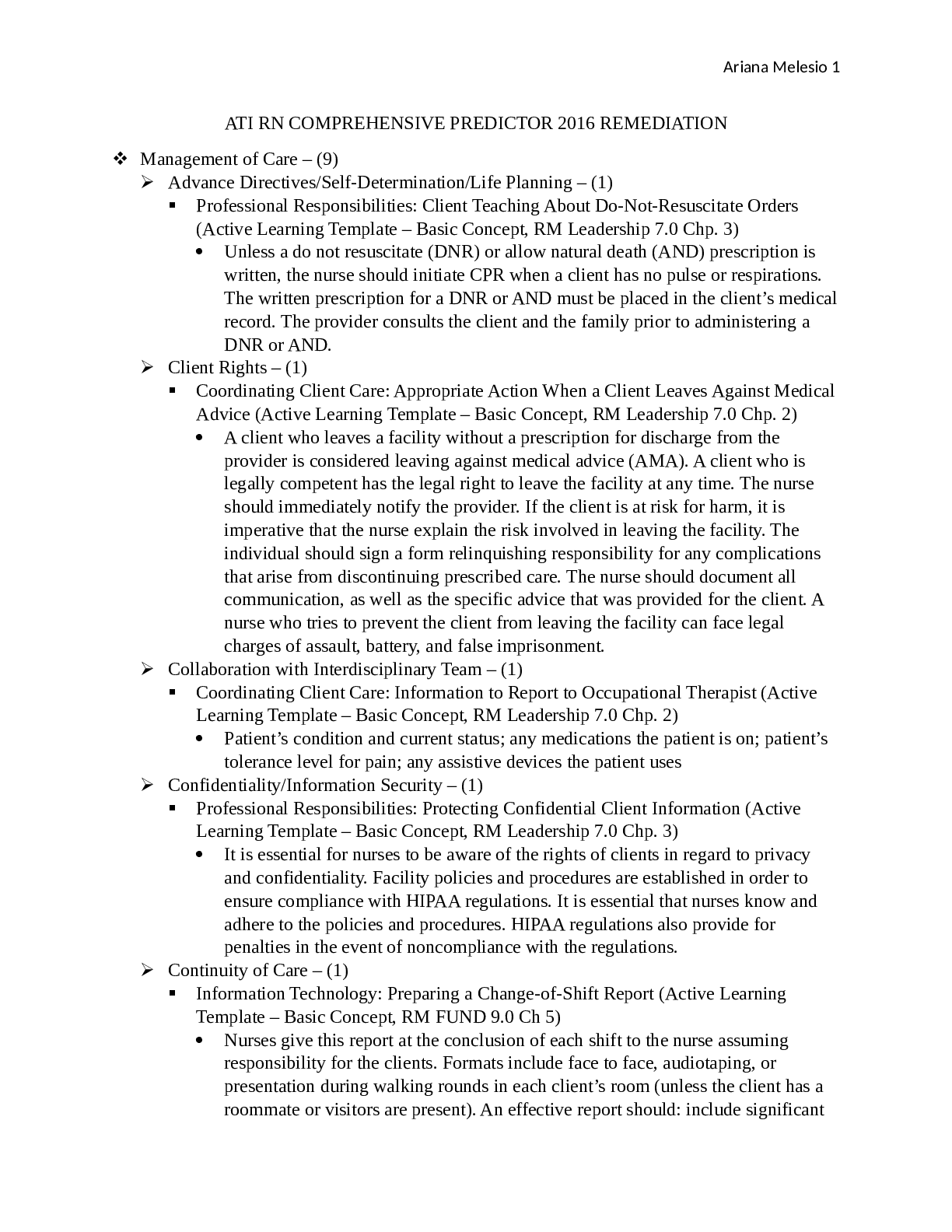
Reviews( 0 )
Document information
Connected school, study & course
About the document
Uploaded On
Feb 11, 2021
Number of pages
13
Written in
Additional information
This document has been written for:
Uploaded
Feb 11, 2021
Downloads
0
Views
96


